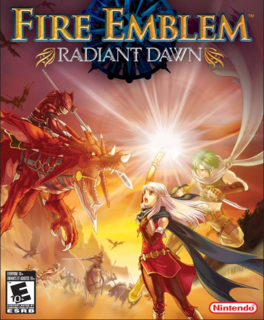Great for fans of the series, not so much for those looking for a solid turn-based strategy experience.
Those familiar with the prequel to Radiant Dawn (RD) will remember the Greil Mercenaries and their leader Ike. Radiant Dawn features the ability to transfer stats from Path of Radiance (POR) and to use those stats and abilities throughout the story of RD. However, the player does not get to begin by playing their old favourites, and is instead introduced to a (relatively) new set of heroes calling themselves the Dawn Brigade. These heroes begin at the lowest levels of a new 3-tier class system, and are thus significantly weaker than their mercenary counterparts. Although a player may increase the levels of these characters until they tear up the battlefield in the 3-part storyline, they are torn away at the end of the segment, leaving you feeling as if you just spent the better of 5 hours accomplishing nothing. Furthermore, when these characters do return later in the story, they are completely outmatched on the battlefield by the powerful units already at the player's disposal.
A nifty feature of RD is its Battle Save feature. In all Fire Emblem games, the main twist to the strategy is that, if a character is defeated in battle, they are (barring certain rare circumstances) gone forever. They are dead, and there is nothing you can do about it. This Battle Save feature allows for the player to set a save state at anytime during their turn, making it incredibly easy to anticipate an opponent's moves and to get lucky critical strikes on a constant basis. There is a limitation in that there can only ever be one of these save states at a time, but that is redundant unless you are playing through multiple campaigns simultaneously. The Battle Save feature (conveniently BS, go figure) also disrupts the flow of gameplay, as the player begins to enter a repetitive rhythm of starting a turn, saving, then continuing onward. The feature also renders difficulty settings obsolete, as it essentially allows players to jump immediately into the hard mode and still achieve a perfect run-through.
Unlike POR, RD also lacks in the replay value department. In POR there was incentive to replay the story in order to unlock bonus characters; in RD there are no bonus characters whatsoever. As was previously mentioned, the Battle Save feature also makes it boring to have to play back through the same story on a "hard" difficulty which is essentially the same as the "easy" or "normal" settings.
There are high points as well though. For one, the battle scenes and cut scenes are beautifully rendered and carried out, and the tactical views of the battlefield offer spectacular overhead views of well designed maps. The game also features the same rock-paper-scissors triangle battle system as all Fire Emblem games have, and brings in new elements that add rather than detract from the experience. Also, unlike its POR, RD allows the player greater customization of character skills and XP, through the ability to strip characters of certain abilities and then give those to another character, something which could not be done in POR. The final chapters also allow for customization, but also a certain amount of replay value, something which I will let you discover on your own.
Although there are many downsides to Fire Emblem: Radiant Dawn, it is still a classic Fire Emblem game, and is not to be ignored by long-time fans of the series.

